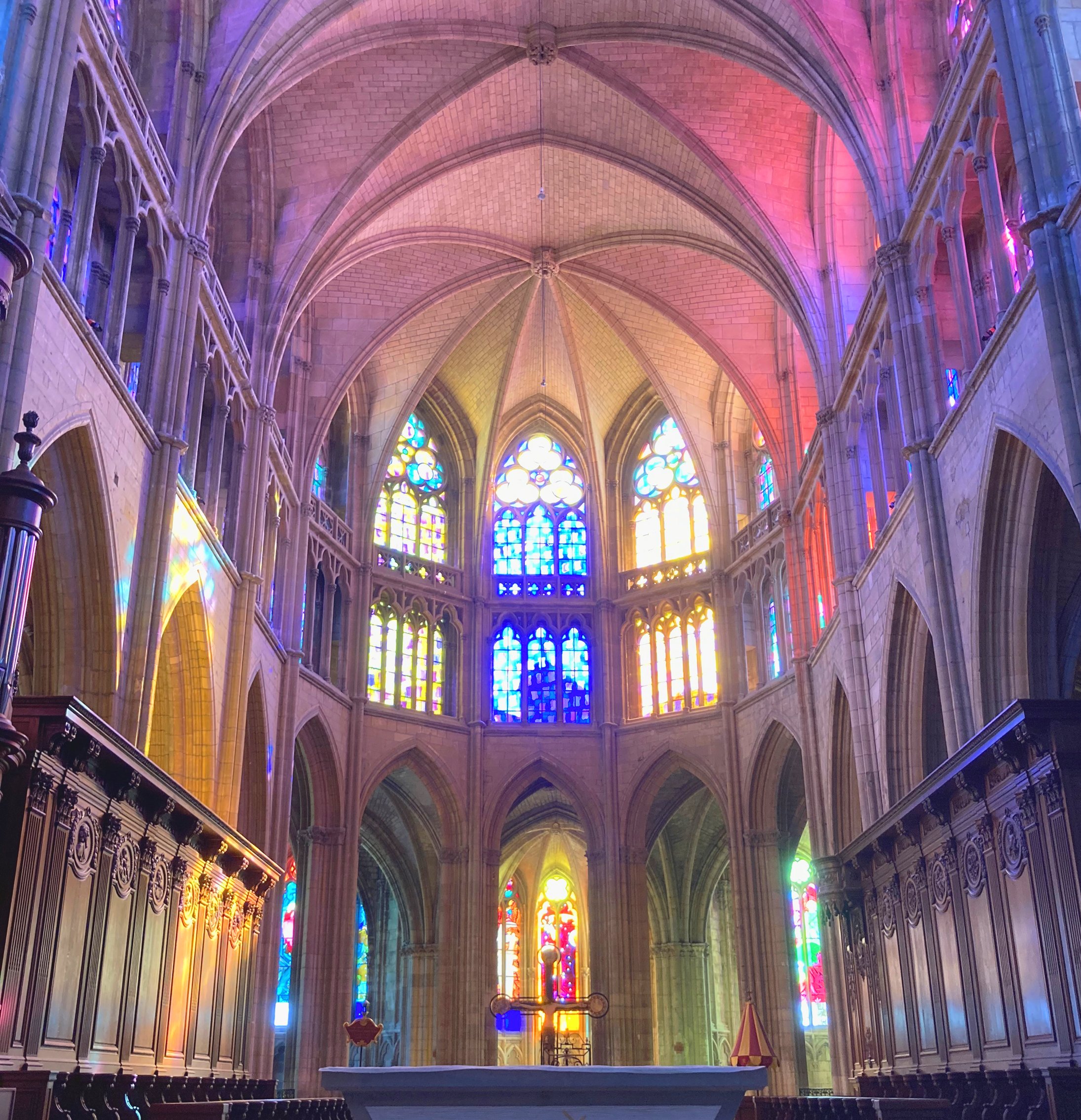Morning sun in Nevers Cathedral
The Cathedral of Saint Cyr and Saint Juliette of Nevers, in the middle of France on the river Loire, is an essential stop on a stained glass road trip as its windows are filled with modern stained glass - that is 1052 square metres in 130 windows designed by five different artists. The gothic east end was blazing with colour on the morning of our visit, projecting right up to the opposite end of the cathedral (below left) where there are four subtle, rhythmic windows by Raoul Ubac. These were the first to be commissioned for this ambitious stained glass project initiated almost forty years after the building was bombed by the Royal Air Force.
Nevers: Left, four windows in the romanesque west end by Raoul Ubac, 1983. Right, upper choir windows by Claude Viallat, 1992.
It is the upper windows in the choir that project most of the colour, this set by Claude Viallat contains a repeated motif (which we called the floating toast) in a gorgeous bright and light colour palette. They act as a bridge between the set of geometric designs by Gottfried Honegger in the windows of the upper nave, and the many windows by Jean-Michel Albérola in the chapels around the apse which you can see in bursts through the cathedral’s interior arches as soon as you enter (above right and top).
There are several useful information boards about the windows in the cathedral, the one below particularly so as it gives the names of the glass studios that worked with each artist and a detail from each set of windows - something I can’t do as I forgot to take my good camera on this trip. The commentary, as always, is keen to interpret the designs in terms of subject matter, whereas in fact the only artist who used figurative imagery is Jean Michel Albérola.
Useful information board in Nevers Cathedral
Nevers: Left, Chapel of the Joyful Mysteries. Right, Blessed Sacrament Chapel, Jean-Michel Albérola, 1993-4.
The figurative path is, I think, the hardest one to choose and to admire. Look at the gorgeous saturated green, orange and pink projected on the floor of the radiant gothic Blessed Sacrament Chapel, and then look again and realise that the white shape is a giant hand silhouette, one of the hands of God. Albérola’s imagery is saturated with motifs from the whole history of European painting, as well as borrowing from traditional stained glass design as you can see in the floral ornamentation, crosshatching and cartoonish figures and hands in the example below.
“I took pieces of images either figurative or decorative which I mixed together, as I usually do… From the beginning, I started with the idea of quotation, without inventing anything”. Albérola quoted in a comrehensive article about these windows in The Spirit of the Eye.
Nevers: Left, two windows by Albérola in the apse. Right, two windows by Gottfried Honegger in the crypt, 2001.
Gottfried Honegger’s windows seem to be exercises in elegant shape and colour, even the information board resists the urge to interpret the simple shapes in his windows for the nave and the crypt (above right). But are they enough? My favourite set, the windows in the side chapels of the nave by François Rouan, hover between the worlds of imagery and abstraction. They play sensitively with the complicated patterns in the tracery using restrained colour combinations and have a huge impact when you stand in front of them (below).
Nevers: Windows by François Rouan in the side chapels of the nave, 1991-6.
Our next stop, 250 miles south, was Rodez and the Cathedral of Notre Dame. Here one artist, Stéphane Belzère, was chosen in a competition launched in 2002 to design seven tall gothic windows in the side chapels around the choir. A condition of the competition was that the windows should contain Christian iconography on set themes using figurative imagery appropriate to the twenty first century. Atelier Duchemin, who made Albérola’s Nevers windows, was chosen as the manufacturer and these windows are also beautifully made and slightly cartoonish with a digital, twenty first century feel.
Rodez: Windows by Stéphane Belzère in the chapels on the east side of the nave (windows completed 2006).
The first window interprets the theme The Blood of Christ (above left) with oversized hands (again) and blood cells. The second window, Resurrection, uses glass that goes from the deepest red to the palest yellow - extreme colour saturation to extreme light - with minimal leading and all details etched, painted and silverstained by the artist (above right).
Rodez: Windows by Belzère in the chapels on the west side representing Saints in Heaven (left) and Genesis (right).
The windows on the west side are taller still, and the top tracery of each is filled with wonderfully multicoloured glass, made with coloured frits. My favourite of them all is the one with the slightly terrifying red border (below centre and right). This one, The Dream of Boaz, contains a version of Jesse’s tree, you can make out figures and faces in the beautifully painted, etched and silverstained bubble. It’s interesting to see the collision of a twenty first century approach to picture making with the cathedral’s architecture and the declared intention of giving people images that interpret the bible in the traditional manner of stained glass windows, a view outlined in the comprehensive explanation panels on display. The whole effect is jumbled, patternless and full of religious content, a thing you rarely find in modern church or cathedral windows.
Rodez: Windows by Belzère in the chapels on the west side, representing Fire (left) and The Dream of Boaz (right).








